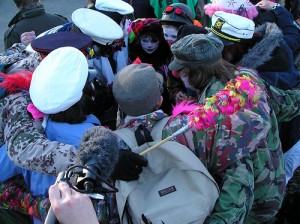 In Engagement Working Group, I discussed an early step in the process of bolstering an organization’s commitment to engagement. Once members of this core group–those who already have an understanding of and firm commitment to this work–have discovered each other and begun talking and planning, it is time to expand the base. Developing allies means turning the non-enthusiastic into supporters or at least convincing them not to be roadblocks.
In Engagement Working Group, I discussed an early step in the process of bolstering an organization’s commitment to engagement. Once members of this core group–those who already have an understanding of and firm commitment to this work–have discovered each other and begun talking and planning, it is time to expand the base. Developing allies means turning the non-enthusiastic into supporters or at least convincing them not to be roadblocks.
Artcentric habits of mind and practice are so deeply rooted that intellectual arguments alone will seldom suffice. They must be made but they, by themselves, will not provide sufficient traction. In particular, the existential threat case, however true, can serve, at best, to gain attention. Those willing to pursue the matter based on “change or die” arguments will need more compelling, more inspirational reasons. Others will simply not believe; some will resist based on assumptions about the mission of the arts. To be honest, those who object out of concern for the mission are to be valued for their commitment to core purpose. The “it’s good for art” argument (vitality, expanded cultural palette, etc.) and some of the pragmatic benefits–increased public support, access to new funding sources, etc.–could be meaningful. Finally, the idea of the arts organization working to enhance the life of the community will have weight with some “on the inside,” especially board members.
Essential Gradualism
Just as important will be reassurance that it is possible to begin engagement work incrementally. That is, the next show/season will not suddenly consist of work foreign to the current staff and support base. Indeed, relationship building is time-consuming work so the results of engagement with new communities should not be immediate or pervasive. This is one place where the lengthy process of engagement is a benefit.
Available Means and Teachable Moments
Building support for engagement will likely be conducted one-on-one unless it is clear that an established group of people is predisposed to favor a community orientation. If that is the case, discussion groups or book clubs may be useful tools.
There is no perfect moment for beginning, but the timing of approach can be important. In a period of institutional crisis, few people can think about change. However, the immediate aftermath of one might be a good point at which to promote new approaches that could make such a crisis less likely in the future. Similarly, cautionary tales from peer organizations can provide opportunity to discuss how to avoid the perils they are encountering, despite the tendency to believe that bad things can never happen to one’s own organization. And, of course, the reflective mode that precedes and begins good planning processes affords the chance to explore new ways of relating to the community.
Engaging the Core
Once a cadre of advocates–including the CEO and board chair (or, alternatively, other members of the executive committee)–has been secured, the rest of the staff and board should be included in this institutional thinking. Readings, presentations, and discussions are all of value in laying the groundwork and obtaining consensus. Not all will become enthusiastic. A reasonable goal would be to have strong support from all key players and, based on the case made, no vehement, vocal opponents (or at least none in a position to sabotage the work).
Engage!
Doug
Photo: ![]()
![]()
![]() Some rights reserved by thealmightyprophetgitboy
Some rights reserved by thealmightyprophetgitboy
